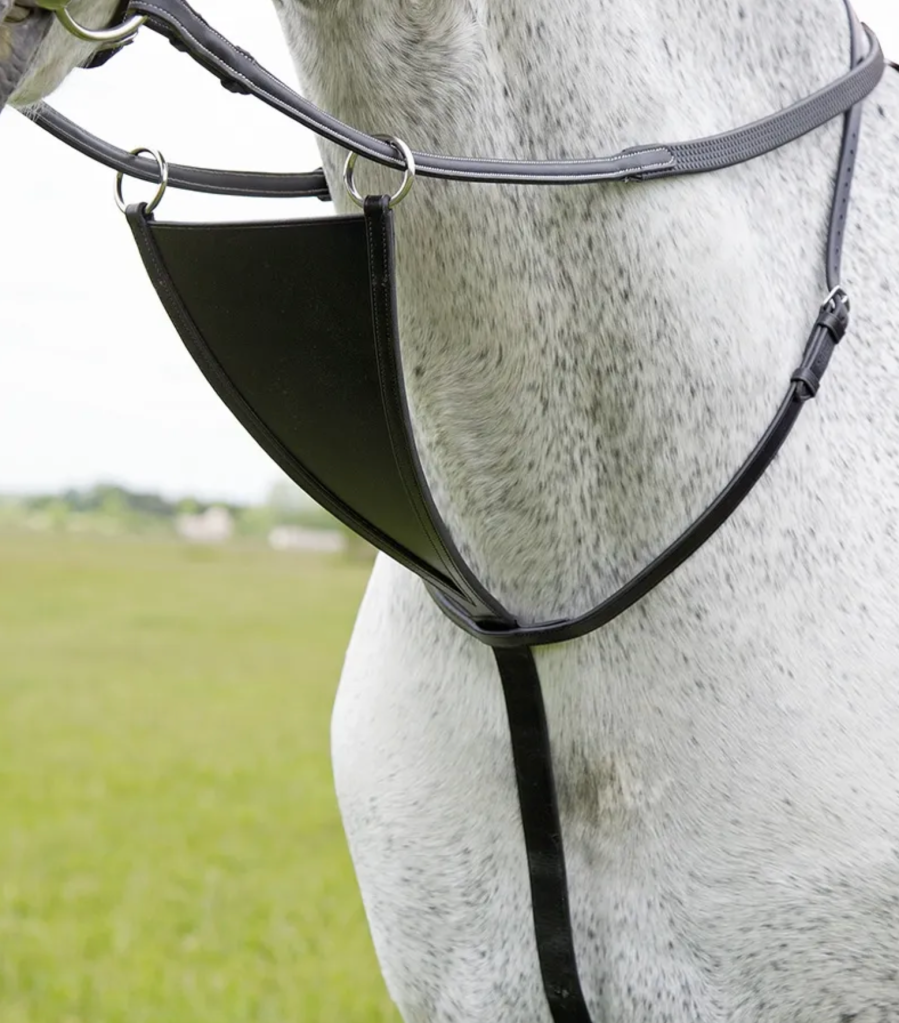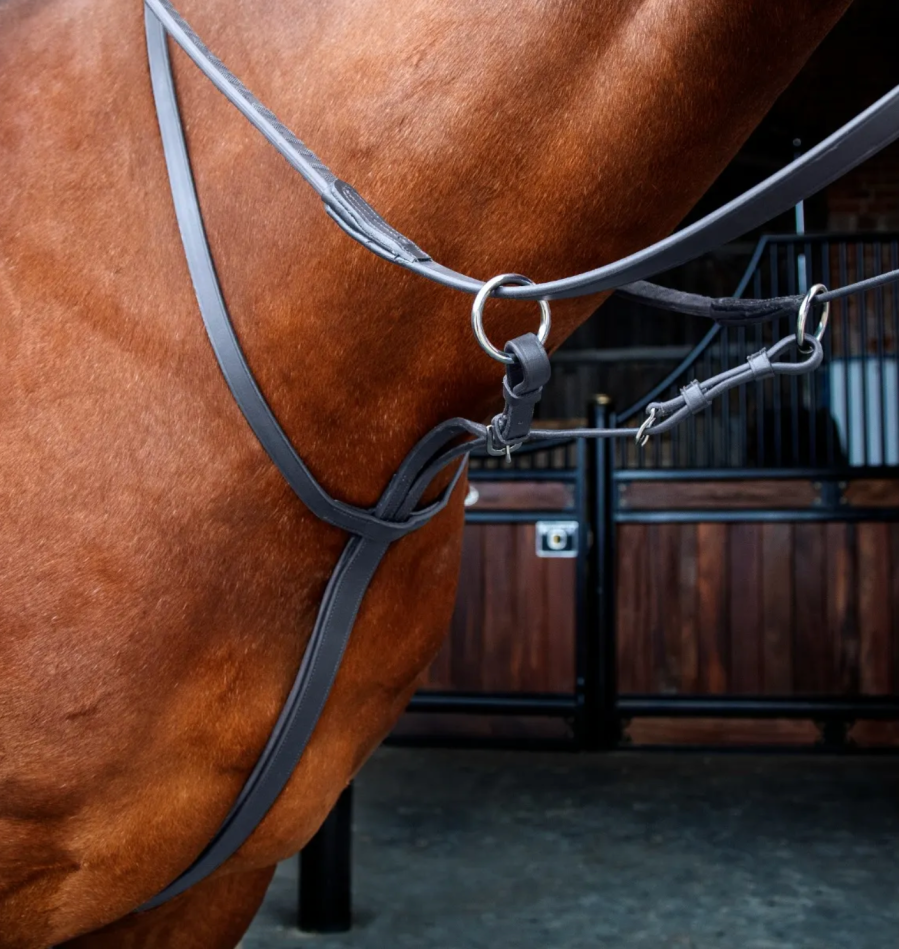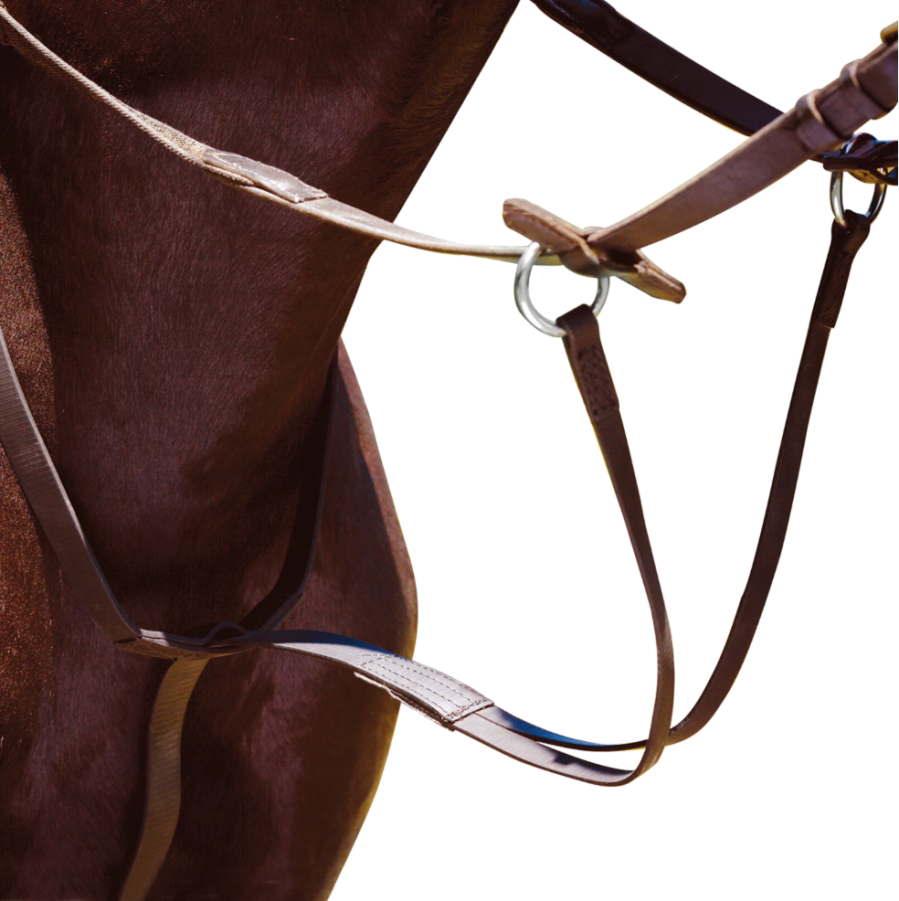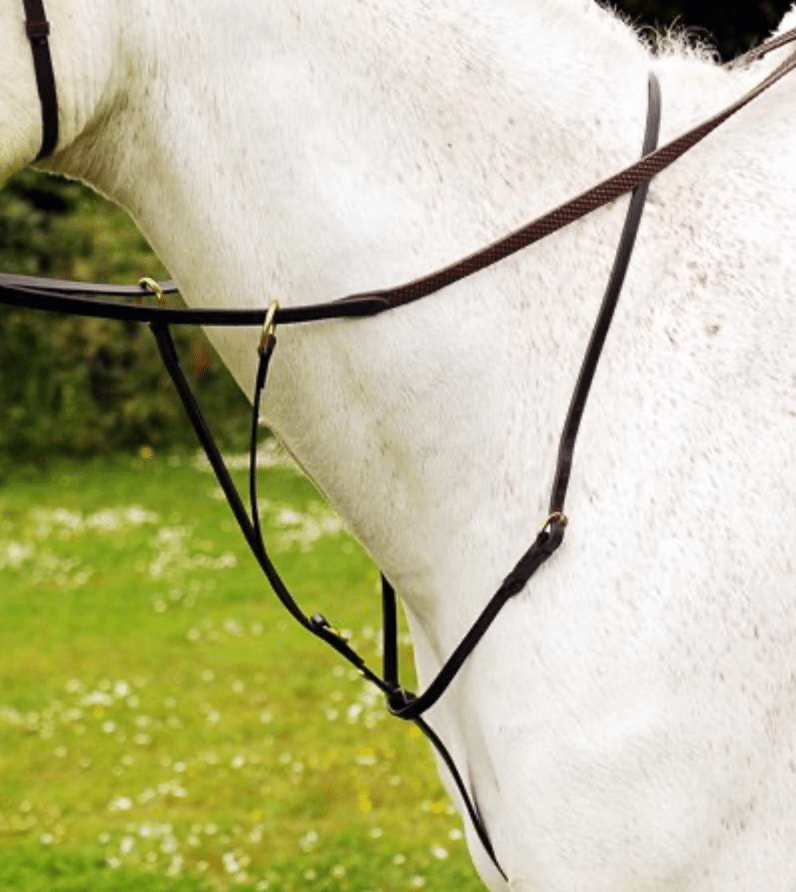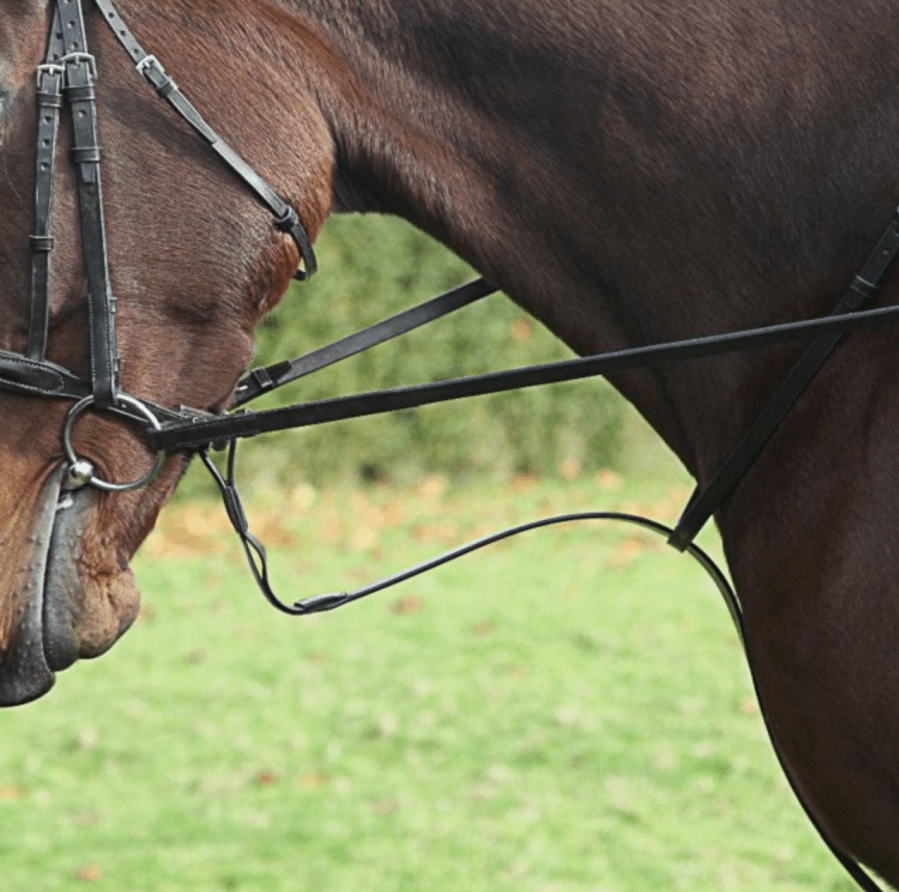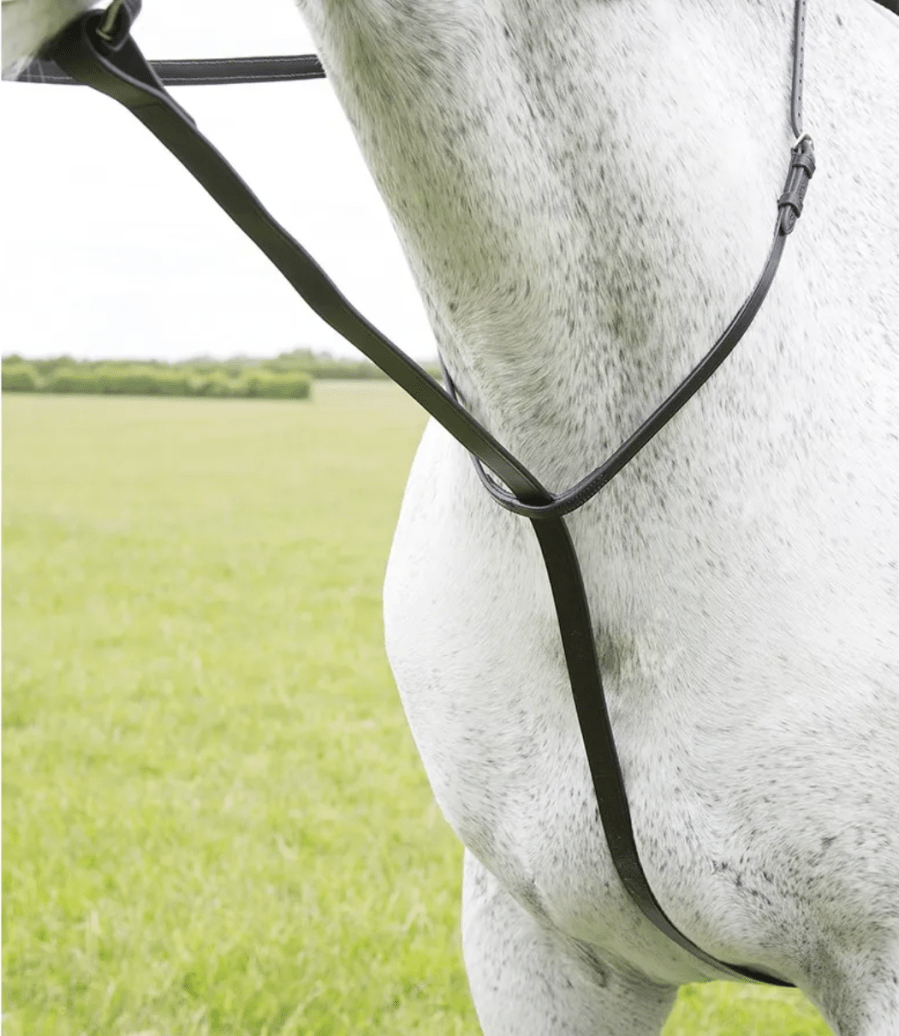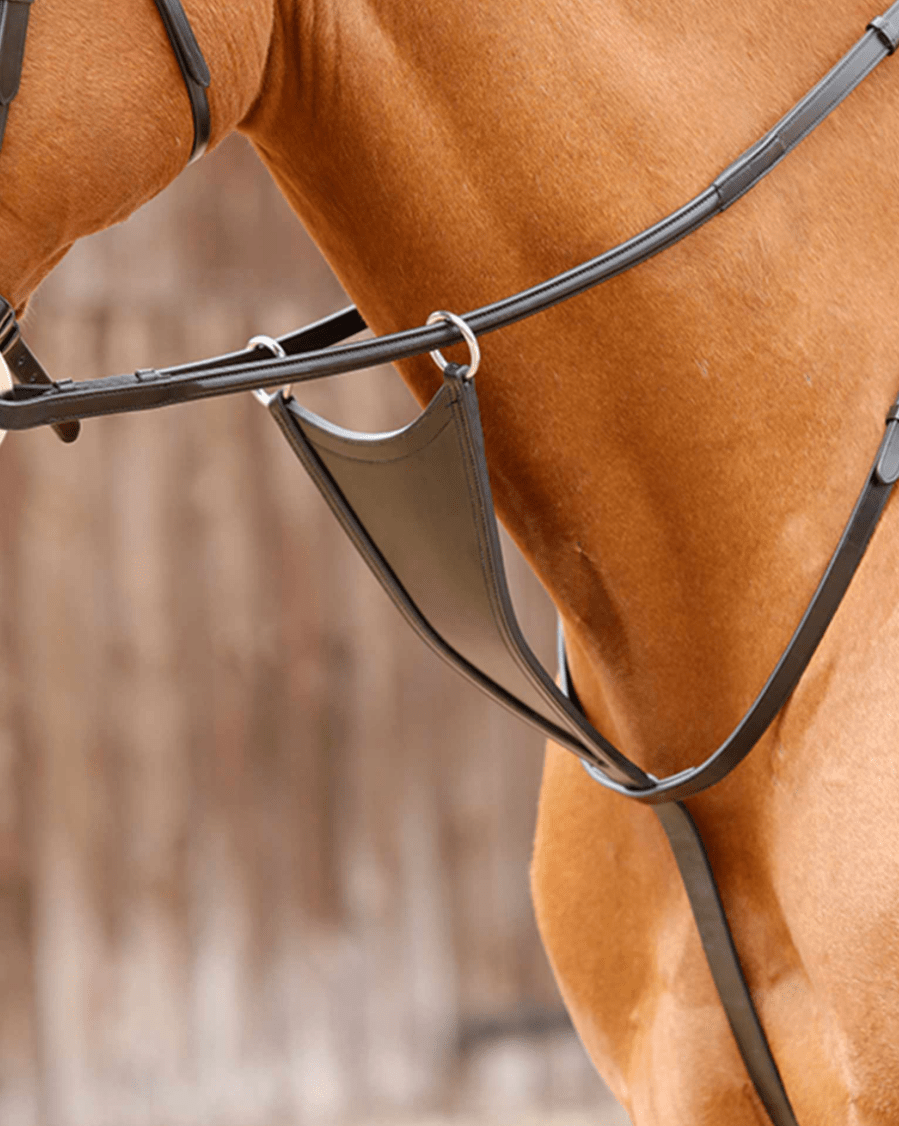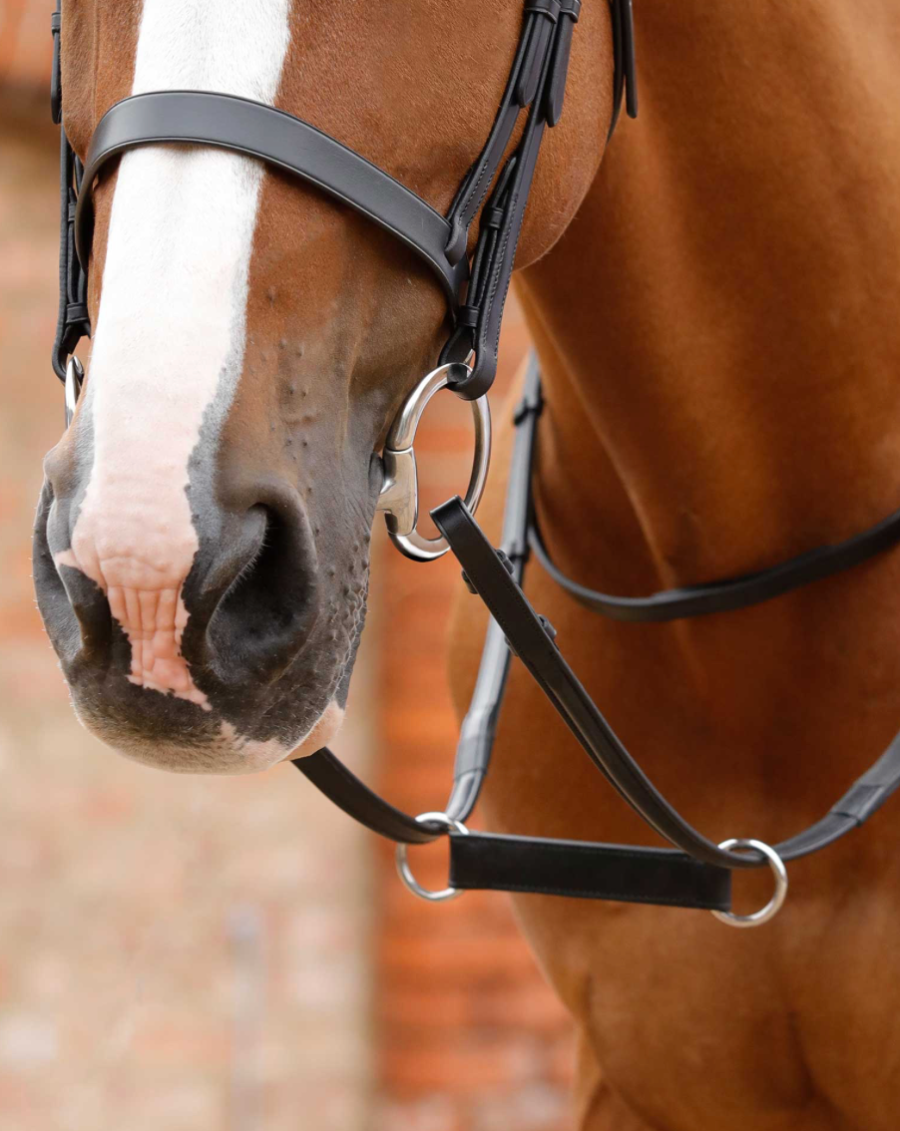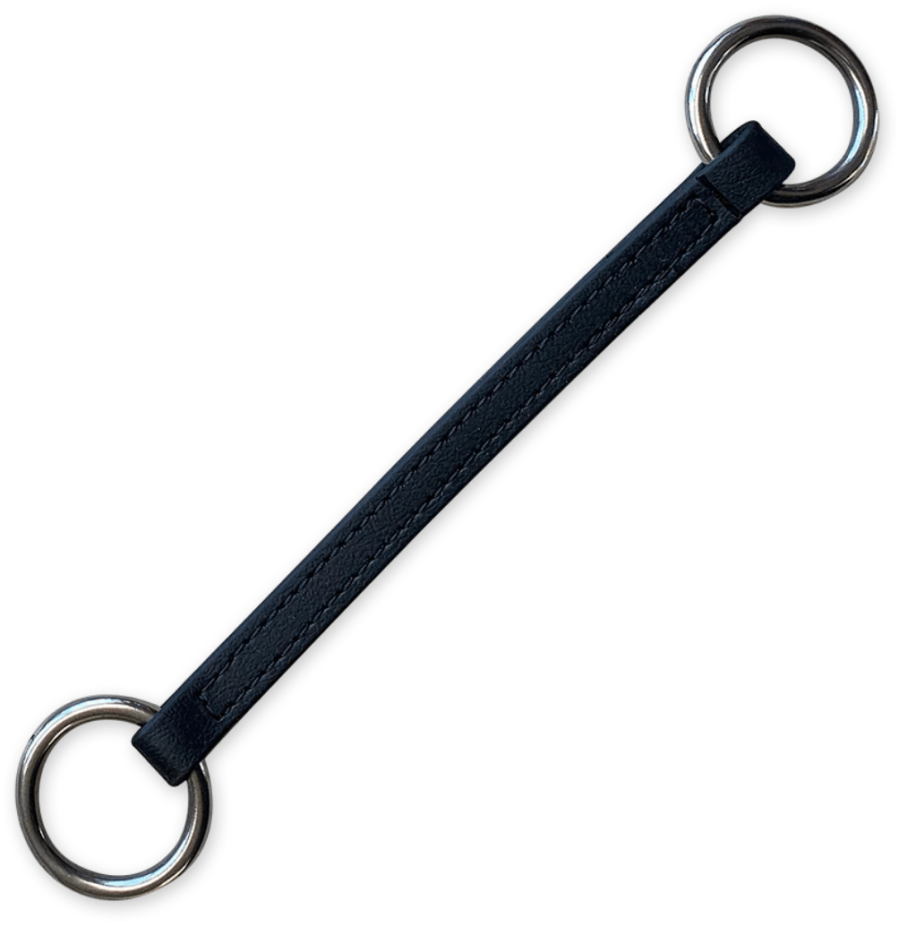A martingale is an item of tack used to control the horse’s head and neck position. It attaches to the girth and bridle to apply pressure should the horse’s head become too elevated. Riders may choose to use a martingale to prevent their horse from raising their head too high, or tossing and nodding excessively.
There are four types of martingales: a running martingale, standing martingale, bib martingale and an Irish martingale. Each style fits differently, works in its own way and does a slightly different job, meaning they are more suitable for some horses than others.
Cast your eye around any competition venue or equestrian facility and you will find that a lot of horses are wearing a martingale.
Do they all actually need to wear them? Possibly not. As with any tack, a martingale shouldn’t be used as a replacement for skilful riding and correct training. When they are used, it is important you understand how each style works and which will best suit your horse in order to aid their performance, rather than hinder.
Types of martingales for horses
Running martingales
Look around any collecting ring and a running martingale is a common sight — lots of horses and ponies wear them.
A running martingale consists of a neck strap with two attachments: one feeds between the horse’s front legs and attaches to the girth, whilst the other forks into two strips of leather with rings on in which the reins are threaded through.
There is a martingale ‘stopper’ on each rein — usually made of either leather or rubber — to stop the martingale rings getting too close to the bit and potentially getting stuck. The stopper is roughly two inches along the rein from the bit.
A running martingale is used to prevent the horse from lifting their head too high. If the horse does lift their head, they will feel pressure on the reins and therefore bit when the running martingale kicks in.

Standing martingales
Similarly to the running martingale, the standing martingale is made up of a neck strap that attaches to the girth between the forelegs. However, rather than attaching to the reins, the other strap runs from the front of the horse’s chest to the noseband.
This creates a fixed point of contact to restrict the horse from lifting their head too high by exerting downward pressure on the horse’s nose through the noseband.
Standing martingales aren’t commonly used these days and it is rare to see one being used. They are thought to be too restrictive on a horse’s head. Most riders choose to use a running martingale instead.
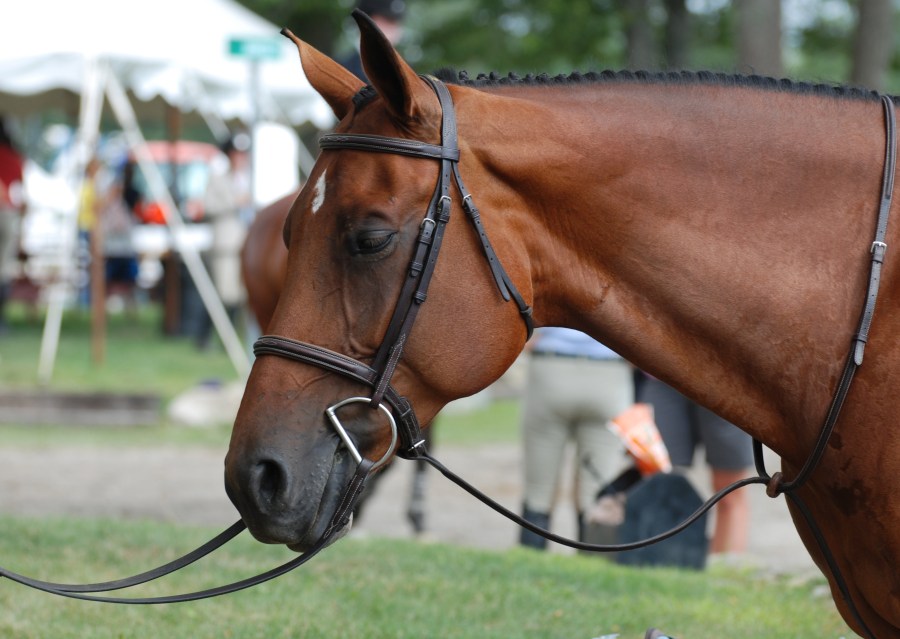
Bib martingales
A bib martingale works in a similar way to a running martingale. The main difference is that there is a triangular piece of leather with two rings on connecting to the reins instead of two separate straps running from the yoke (this is where the neck strap, girth strap and two straps with rings all meet in the middle of the horse’s chest) to the reins.
It is important to understand that a bib martingale has a stronger affect that a running martingale, and is most often seen in racing and eventing. You may also see it on horses in the hunting field.

Irish martingales
An Irish martingale is a small leather strap with a ring on each end that the reins are threaded through. The strap sits on the underside of the horse’s neck and prevents the reins from coming over the horse’s head should the rider fall off.
This is its sole job, and is why an Irish martingale is a common sight on the reins of racehorses. This type of martingale does not influence the horse’s head carriage.

How to fit a horse’s martingale
Martingales come in a range of sizes from pony to extra-full for those horses who have very long necks. Once you’ve selected the right size, there are three areas to adjust: the length of the neck strap, the length of the girth attachment and the length of the rein or noseband attachment.
Fitting the neck strap
The neck strap should sit comfortably around the horse’s neck without being too tight or hanging down too loose. You should be able to comfortably fit three fingers between the neck strap and the horse’s neck. The centre of the neck strap should sit below where the horse’s neck meets their chest.
Fitting the girth strap
The girth attachment should be long enough to run between the horse’s front legs and reach the girth. Depending on the style of martingale, it will either be clipped on to a D ring or the girth will thread through the end of the martingale attachment. This part of the martingale should run close to the horse’s chest without applying pressure, and should not droop down between the horse’s legs.
Attaching to the reins
On a running martingale, each rein should be threaded through the corresponding ring (ie one on each side of the horse’s neck without the martingale straps twisting or crossing over each other). Martingale stoppers should be threaded onto the reins first to sit between the bit and the martingale rings to prevent them from becoming caught in the buckles and billets or interfering with the bit rings.
On a standing martingale, the leather should be attached to the back of the noseband, in the centre.
When fitting either martingale, it’s important that the attachments are not fitted so tightly that the horse can’t raise their head at all. This could cause them to panic or fight the martingale, and potentially cause them (or you) an injury.
There should be no pressure from the martingale put on the horse when their head is lowered or carried in a neutral position; it should only apply pressure when their head is highly elevated in the air.
Who should use a martingale?
A martingale should only be used when needed and it must be fitted correctly in order to do its job properly. If you are unsure about fitting a martingale for your horse, or you are using one for the first time, always ask a trainer or someone experienced and qualified for advice, as it’s important to get it correct.
A martingale is really only necessary on a horse or pony who has a tendency to carry their head too high. If you like to have a neck strap and your horse doesn’t require a martingale, consider a breastplate or purpose-made neck strap instead.
Martingale vs breastplate
The main difference between a martingale and a breastplate is that the latter is used to secure the saddle and prevent it from slipping backwards. It sits around the horse’s chest in a slightly different way to a martingale and attaches to the saddle as well as the girth. Many breastplates come with attachments for martingales too, which is really useful, and are a popular choice for riders who need to secure their saddle and limit their horse from tossing their head.
Shop for a martingale
Unless otherwise stated, the following martingales haven’t yet been tested by Your Horse’s products team.
Shires Velociti RAPIDA Running Martingale
Engineered with the horse’s anatomy in mind, the Velociti RAPIDA running martingale is constructed for both performance and comfort. It is adjustable at the neck, girth and martingale straps. Supple and hardwearing, the leather is eco-friendly vegetable-tanned leather, hand-stitched with self-colour thread and finished with high shine stainless steel harness buckles.
Colours: Black or havana
Sizes: Pony, cob, full, extra-full
RRP £33.99
Buying in the UK? Purchase here
Santadi Adjustable Running Martingale
Colours: Black or brown
Sizes: Cob, full
RRP £52
Buying in the UK? Purchase here
Wintec Running Martingale
This martingale from Wintec comes in three sizes and two colour variations.
Colours: Black or brown
Sizes: Pony, cob, full
RRP £46.99
Buying in the UK? Purchase here
Kate Negus Running Martingale
This running martingale from Kate Negus has a discreetly placed D ring on the underside to allow you to attach either a standing attachment, draw reins or other equipment should you wish. The martingale comes with a rubber martingale stop.
Colours: Black or chestnut
Sizes: Small, medium, large
RRP from £135
Buying in the UK? Purchase here
International delivery available
Stübben Running Martingale
This martingale from Stubben is made of top-quality cow hide and features either silver- or gold-coloured fittings. In addition to the conventional options for adjustment, the separate and adjustable fork ensures an individual fit for each horse. The rings are made of high-quality and ultra-light plastic material, and are completely smooth on the inside, thus enabling the reins to glide.
Colours: Black, ebony, Havana, tobacco
Sizes: Pony, CS, FS, XFS
RRP from £109
Buying in the UK? Purchase here
Gressen Standing Martingale
This martingale from Premier Equine is fully adjustable with buckles at the shoulder and girth for full adjustability. The looped ending on the neck strap allows the martingale to be fixed to the horse’s cavesson noseband. It is finished with premium quality stainless steel fixtures.
Colours: Black or brown
Sizes: Cob or full
RRP £44
Buying in the UK? Purchase here
Townfields Elastic Standing Martingale
This martingale from Townfields is made from English leather whilst the elastic allows for some give.
Colours: Black or havana
Sizes: Cob, full, x-full
RRP £47
Buying in the UK? Purchase here
Velociti GARA Standing Martingale
The Velociti GARA standing martingale has two points of adjustment. It is made from Blenheim leather and has stainless steel fittings.
Colours: Black, Havana
Sizes: Pony, cob, full
RRP £27.99
Buying in the UK? Purchase here
Rosello Bib Martingale
This martingale is made from luxury Italian leather and can be fully adjusted around the shoulder and girth in order to achieve an ideal fit.
Colours: Black, brown
Sizes: Cob, full
RRP £64
Buying in the UK? Purchase here
Velociti GARA Bib Martingale
The Velociti GARA bib martingale, helps prevent widening of the reins for better control and reduces the risk of straps becoming caught up. It is made from Blenheim leather and features stainless steel fittings.
Colours: Black or havana
Sizes: Cob, full
RRP £35.95 (sale price)
Buying in the UK? Purchase here
Devoucoux Bib Martingale
This bib martingale from Devoucoux aims to limit the movements of the horse’s head and is a useful training aid when used correctly. Designed to channel the horse’s movements, this bib martingale provides a fixed corridor and prevents it from catching the martingale straps.
Colours: Black or medium brown
Size: Medium
RRP £105
Buying in the UK? Purchase here
Esperia Irish Martingale
This simple martingale is made from Italian leather strap and has stainless steel rings.
Colours: Brown or black
Size: Full
RRP £11
Buying in the UK? Purchase here
Fairfax Race Irish Martingale
The Fairfax Irish martingale is an essential part of race day safety equipment and is designed to coordinate with the widely used Fairfax race bridles.
Colour: Black
Size: One size
RRP £8
Buying in the UK? Purchase here
International delivery available

